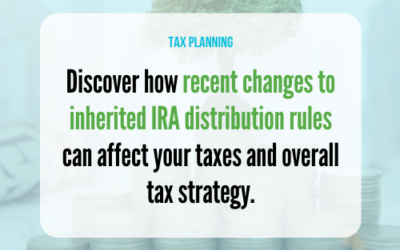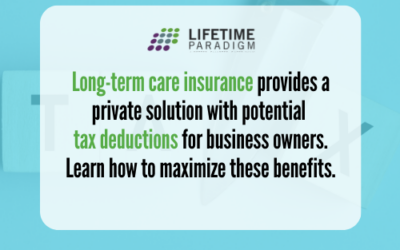Tax Planning
The Smart Tax Planning Newsletter August 2024
In This Issue:
- Tax Guide to Deducting Long-Term Care Insurance Premiums
- Smart Solutions That Decrease Social Security and Medicare Taxes
- What Happens When You Die and Your S Corporation Owns the Rental?
- Reduce Taxes by Using the Best Cryptocurrency Accounting Method
- Avoid the Hidden Dangers of the Accumulated Earnings Penalty Tax
Tax Guide to Deducting Long-Term Care Insurance Premiums
Long-term care costs can be substantial, and neither Medicare nor Medicaid provide comprehensive coverage for most people. Long-term care insurance can help protect your finances, and there may be ways to deduct the premiums, depending on your business structure.
Here are four key points to consider:
- C corporations can provide long-term care insurance as a fully deductible, tax-free benefit to owners.
- Sole proprietors or single-member LLCs with a spouse as the only employee may be able to deduct 100 percent of the premiums through a Section 105-HRA plan.
- S corporation owners, partners, and other sole proprietors may be able to deduct premiums subject to age-based limits.
- If you don’t qualify for business-related deductions, you might deduct premiums as itemized deductions subject to age-based limits and the 7.5 percent floor.
(For more details on Deducting Long-Term Care Insurance, click here.)
Smart Solutions That Decrease Social Security and Medicare Taxes
Here are some important updates and strategies regarding Social Security and Medicare taxes that may significantly impact your business.
For 2024, the Social Security tax ceiling increased to $168,600, resulting in a maximum Social Security tax of $20,906 for high-earners. The Social Security Administration projects this ceiling to rise annually, reaching $242,700 or more by 2033. Additionally, the government adds a 2.9 percent Medicare tax to all wages and self-employment income, with an extra 0.9% for high-income earners.
If you’re self-employed, these taxes can be particularly burdensome. Here are three strategies that can potentially reduce your tax liability:
- Operate as an S corporation. This structure allows the corporation to pay you a reasonable salary and distribute the remaining profits to you, exempt from self-employment taxes.
- Leverage community property rules. Married filers living in community property states can use IRS rules to eliminate or create a spouse partnership in order to reduce self-employment taxes.
- Avoid the husband-wife partnership classification. With close attention to partnership attributes, you can avoid the husband-wife partnership classification and reduce overall self-employment taxes.
Each of these strategies has specific requirements and potential trade-offs.
What Happens When You Die and Your S Corporation Owns the Rental?
You may own an S corporation with a rental property as its sole asset.
A common concern with this approach is what happens when the owner passes away, specifically regarding the step-up in basis.
Here’s good news. While technically the rental property itself doesn’t receive a step-up in basis upon your death, your heirs will achieve the same outcome. It works like this:
- Your heirs inherit the S corporation stock at its stepped-up fair market value.
- When the S corporation sells the rental property, it recognizes a gain.
- The gain on the rental property increases your heirs’ basis in the S corporation stock.
- Upon liquidation of the S corporation, your heirs recognize a capital loss that offsets the earlier gain.
The result is that your heirs can potentially sell the property without incurring any federal income tax liability, effectively achieving the same outcome as they would with a traditional rental property basis step-up.
Reduce Taxes by Using the Best Cryptocurrency Accounting Method
Consider this happy scenario: You purchased one Bitcoin for $15,000 14 months ago and another six months later for $40,000. Today, you sell one Bitcoin for $60,000. You’re a genius! But is your taxable gain $45,000 or $20,000?
It all depends on your crypto accounting method.
Many crypto owners are enjoying substantial gains at a time of surging cryptocurrency prices. When you sell multiple crypto units in the same year, you reduce your taxable gains using a crypto accounting method that provides the highest possible tax basis for each unit sold, resulting in the lowest taxable profit.
As you might expect, the default method approved by the IRS doesn’t always provide the highest basis, resulting in higher taxes. The IRS made FIFO (first in, first out) the default method. It requires you to calculate your basis in chronological order for each crypto unit sold. With FIFO, your basis in the above example is $15,000, and your taxable profit is $45,000.
You can use a method other than FIFO. The other methods are called “specific identification methods” and include HIFO (highest in, first out) and LIFO (last in, first out). With HIFO, you are deemed to sell the crypto units with the highest cost basis first; your basis in the above example would be $40,000, and your taxable profit only $20,000.
Because HIFO sells your crypto with the highest cost basis first, it ordinarily results in the lowest capital gains and the largest capital losses. But using HIFO can cause loss of long-term capital gains treatment if you have not held the crypto for more than one year.
Using HIFO or LIFO is more complicated than using FIFO. You must keep records showing:
- the date and time you acquired each crypto unit,
- your basis and the fair market value of each unit at the time it was acquired,
- the date and time each unit was sold or disposed of, and
- the fair market value of each unit when sold or disposed of.
If you lack adequate records, the IRS will default to the FIFO method during an audit, which could result in more taxable profit.
It’s next to impossible to manually create the needed crypto records, particularly if you have many trades. Most crypto owners use specialized crypto tax software that automates the basis and gain/loss calculations and can even fill out the required tax forms.
You can change your crypto accounting method from year to year without obtaining IRS permission—for example, you can change from FIFO to a specific identification method such as HIFO. You don’t have to disclose which method you use on your tax return.
Avoid the Hidden Dangers of the Accumulated Earnings Penalty Tax
If you run your business as a regular C corporation, beware of the accumulated earnings tax (AET).
The IRS can use the AET to penalize C corporations that retain earnings in the business rather than pay them to shareholders as taxable dividends. When retaining earnings, the C corporation first pays the corporate tax of 21 percent on those earnings.
When the corporation distributes those already taxed earnings to shareholders, the shareholders include those distributed earnings as dividends in their taxable income, where they are taxed again at the shareholders’ capital gains rate.
The AET is a flat 20 percent tax. It is a penalty tax imposed after an audit in which the IRS concludes that the corporation paid out insufficient dividends when compared with the amount of income accumulated by the corporation.
You have AET exposure when your C corporation has large balances in retained earnings, cash, marketable securities, or loans to shareholders reported on its balance sheet on IRS Form 1120, Schedule L.
The IRS can impose the AET on any C corporation, including public corporations. However, closely held C corporations are the most likely targets because their shareholders have more influence over dividend policy than do public corporations’ shareholders.
Historically, IRS auditors have not prioritized the AET, but anecdotal evidence suggests this may change.
Fortunately, there are many ways to avoid problems with the AET—for example:
- Elect S corporation status.
- Retain no more than $250,000 in earnings ($150,000 for corporations engaged in many types of personal services)—all C corporations are allowed to retain this much without incurring the AET.
- Establish that the corporation needs to retain earnings above $250,000/$150,000 for its reasonable business needs—for example, to provide necessary working capital, fund expansion needs, pay debts, or redeem stock.
The key to avoiding the AET is to document the reasons for accumulating earnings beyond $250,000/$150,00 in corporate minutes, board resolutions, business plans, budget documents, or other contemporaneous documentation.

SERVICES WE OFFER RELATED TO THIS TOPIC
The information contained in this post is for general use and educational purposes only. However, we do offer specific services to our clients to help them implement the strategies mentioned above. For specific information and to determine if these services may be a good fit for you, please select any of the services listed below.
The 4x4 Financial Independence Plan ℠
The Smart Tax Minimizer ℠ (For Consumers and Home-Based Businesses)
The Smart Tax Planning System for Business Owners ℠
The Smart Social Security Benefits Maximizer/Retirement Healthcare Expense Estimator ℠
Estate Planning
Retirement Planning
Tax Planning
Coaching and Consulting
Inherited an IRA? Four Things Every Beneficiary Should Know
Inherited IRA distribution rules have changed in ways that can significantly impact your taxes and tax...
Cybersecurity Monthly Newsletter August 2024
Asset Protection In this issue: National Public Data Breach: What You Need to Know About the Massive Cybersecurity...
Tax Guide to Deducting Long-Term Care Insurance
Tax PlanningBradford Tax InstituteYou may not have thought much about long-term care insurance—but you should. Chronic...
Investment Advisory Services are offered through Lifetime Financial, Inc., a Registered Investment Advisory. Insurance and other financial products and services are offered through Lifetime Paradigm, Inc. or Lifetime Paradigm Insurance Services. Neither Lifetime Financial, Inc. nor Lifetime Paradigm, Inc., or its associates and subsidiaries provide any specific tax or legal advice. Only guidance is provided in these areas. For specific recommendations please consult with a qualified, licensed Advisor. Past performance is no guarantee of future results. Your results can and will vary. Investments are subject to risk, including market and interest rate fluctuations. Investors can and do lose money and, unless otherwise noted, they are not guaranteed. Information provided is for educational purposes only and is not intended for the sale or purchase of any specific securities product, service or investment strategy. BE SURE TO FIRST CONSULT WITH A QUALIFIED FINANCIAL ADVISER, TAX PROFESSIONAL, OR ATTORNEY BEFORE IMPLEMENTING ANY STRATEGY OR RECOMMENDATION DISCUSSED HEREIN.
This message is intended for the use of the individual or entity to which it is addressed and may contain information that is privileged, confidential and exempt from disclosure under applicable law. If you are not the intended recipient, any dissemination, distribution or copying of this communication is strictly prohibited. If you think you have received this communication in error, please notify us immediately by reply e-mail or by telephone (800) 810-1736 and delete the original message.
This notice is required by IRS Circular 230, which regulates written communications about federal tax matters between tax advisors and their clients. To the extent the preceding correspondence and/or any attachment is a written tax advice communication, it is not a full "covered opinion." Accordingly, this advice is not intended and cannot be used for the purpose of avoiding penalties that may be imposed by the IRS.






